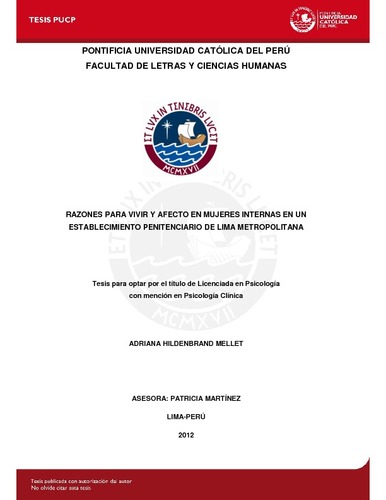| dc.contributor.advisor | Martínez Uribe, Patricia | es_ES |
| dc.contributor.author | Hildenbrand Mellet, Adriana | es_ES |
| dc.date.accessioned | 2013-03-14T01:33:54Z | es_ES |
| dc.date.available | 2013-03-14T01:33:54Z | es_ES |
| dc.date.created | 2012 | es_ES |
| dc.date.issued | 2013-03-13 | es_ES |
| dc.identifier.uri | http://hdl.handle.net/20.500.12404/4428 | |
| dc.description.abstract | En la presente investigación se exploran las razones para vivir, la calidad del afecto y la
relación entre ambas, en un grupo de 46 mujeres entre 19 y 30 años de edad en un
establecimiento penitenciario de Lima Metropolitana. Se utilizaron el inventario de Razones
para Vivir en Adultos Jóvenes (RFL-YA) y la escala de Afecto Positivo y Afecto Negativo
(PANAS). Por tratarse de una población con características particulares con la que se han
realizado escasas investigaciones en el Perú, se exploró el comportamiento de las
variables según características sociodemográficas, como edad, grado de instrucción y
procedencia; y jurídicas, como situación jurídica, tiempo de sentencia, tiempo de reclusión,
entre otras. Se encontró que la razón para vivir más importante en el grupo es Expectativas
a Futuro, mientras la menos importante es Relaciones con Pares. En cuanto al afecto, el
grupo muestra una tendencia a sentir afectos positivos con mayor intensidad que
negativos. Al explorar la relación entre las variables, se encontró que dos áreas del RFLYA,
Relaciones Familiares y Expectativas a Futuro, correlacionan de manera positiva con
Afecto Positivo, mientras un área, Autoevaluación Positiva, correlaciona de manera positiva
con Afecto Positivo y de manera negativa con Afecto Negativo. En las comparaciones de
grupos se encontró diferencias significativas según grado de instrucción en Relaciones
Familiares, Relaciones con Pares y Autoevaluación Positiva, según situación jurídica en
Relaciones con Pares y según tiempo de sentencia en Afecto Positivo.
Palabras clave: Razones para vivir, afecto, encarcelamiento, internas | es_ES |
| dc.description.abstract | The present study explores the reasons for living, the levels of positive and negative affect
and the relationship between reasons for living and affect in a group of 46 incarcerated
women, between 19 and 30 years old. The instruments used were the Reasons for Living
Inventory for Young Adults (RFL-YA) and the Positive Affect and Negative Affect Scale
(PANAS). Results show the most important reason for living in the group is Future
Expectation and the less important, Peer Relations. Regarding the affect, there is a
tendency in the group to feel Positive Affect more strongly than Negative Affect in the last
month. Significant differences were found between people with different educational level,
legal position and length of sentence.
Key words: Reasons for living, affect, incarcerated woman | es_ES |
| dc.language.iso | spa | es_ES |
| dc.publisher | Pontificia Universidad Católica del Perú | es_ES |
| dc.rights | Atribución-NoComercial-SinDerivadas 2.5 Perú | * |
| dc.rights | info:eu-repo/semantics/openAccess | es_ES |
| dc.rights.uri | http://creativecommons.org/licenses/by-nc-nd/2.5/pe/ | * |
| dc.subject | Afecto. | es_ES |
| dc.subject | Relaciones familiares | es_ES |
| dc.subject | Prisiones--Mujeres--Perú--Lima | es_ES |
| dc.subject | Mujeres--Salud mental | es_ES |
| dc.title | Razones para vivir y afecto en mujeres internas en un establecimiento penitenciario de Lima Metropolitana | es_ES |
| dc.type | info:eu-repo/semantics/bachelorThesis | es_ES |
| thesis.degree.name | Licenciado en Psicología Clínica | es_ES |
| thesis.degree.level | Título Profesional | es_ES |
| thesis.degree.grantor | Pontificia Universidad Católica del Perú. Facultad de Letras y Ciencias Humanas. | es_ES |
| thesis.degree.discipline | Psicología Clínica | es_ES |
| renati.discipline | 313026 | es_ES |
| renati.level | https://purl.org/pe-repo/renati/level#tituloProfesional | es_ES |
| renati.type | http://purl.org/pe-repo/renati/type#tesis | es_ES |
| dc.publisher.country | PE | es_ES |
| dc.subject.ocde | https://purl.org/pe-repo/ocde/ford#5.01.00 | es_ES |






